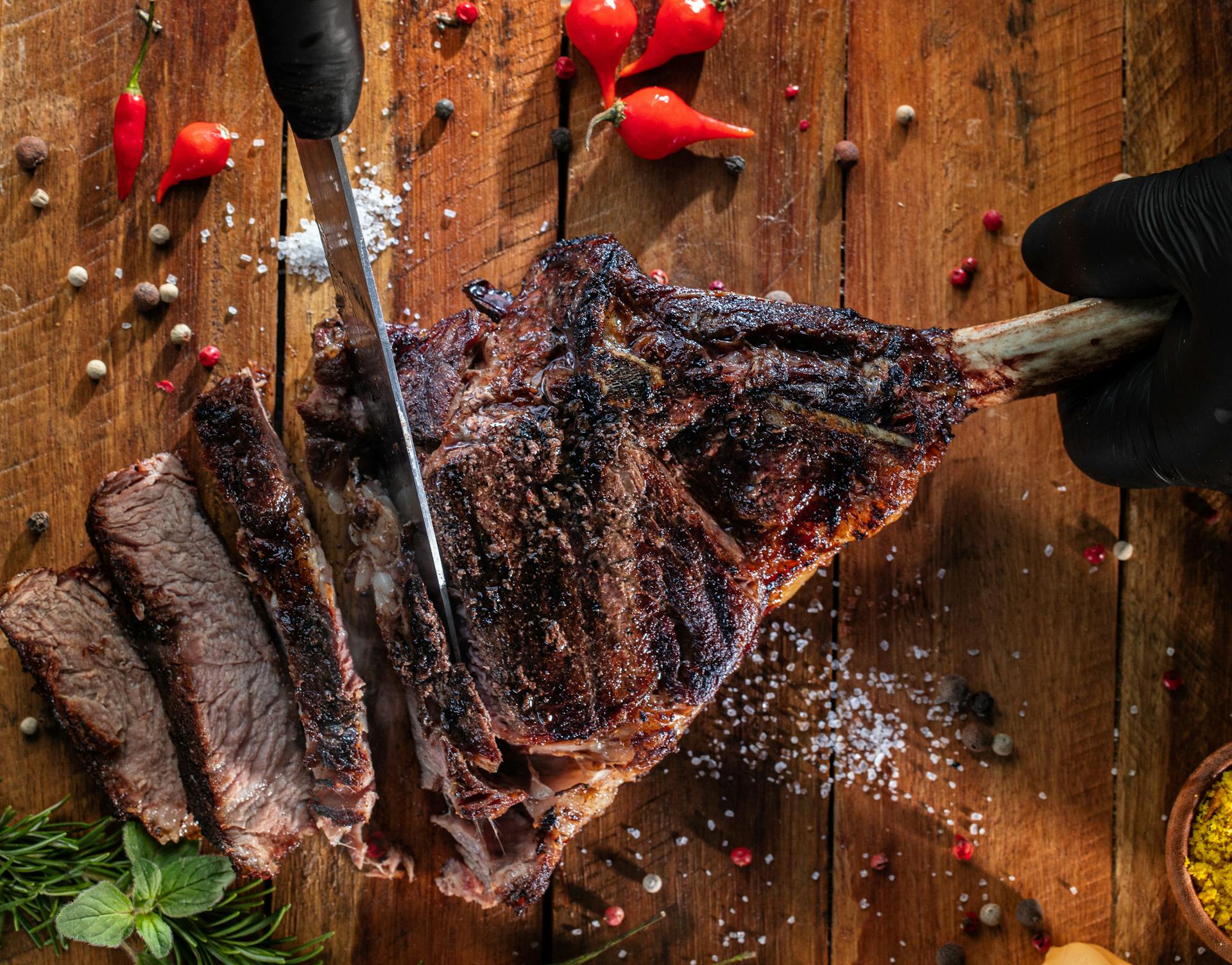
If you’re trying to watch your calorie intake, you’ll want to think twice before indulging in a slice of your favorite ham lunch meat. Not all hams are equal, and the calories can vary tremendously depending on the type of meat and how it was processed. So how many calories are in a single slice?
Fortunately, most regular-sized slices of typical ham lunchmeat (i.e., deli or pre-sliced) contains about 40 calories per ounce (or 50-70 calories per thick slice). For instance: A thin 1 oz slice of cooked natural ham typically contains around 43 calories; while an extra-thick 3 oz sliced version can contain up to 131 calories! It's important that if you decide to include this lunch option in your diet plan, that you take into consideration what type of meat it is and the thickness before making any assumptions about calorie content. Furthermore, pay attention to nutrition labels as specific meats may have higher levels saturated fat or sodium which could increase their caloric count.
Keep in mind that just one simple switch can make a difference in terms of calorie intake - for example: switched from ham to turkey usually decreases the range between 40 - 120 total for a one ounce slice! In conclusion, when considering ham as part of your lunchtime routine yyou want to be mindful of both size/type - these two factors play an important role when it comes down calculating how manycalaories ina each serving size!
Expand your knowledge: Turkey Lunch Meat
How many calories in 3 ounces of sliced ham lunch meat?
If you’re trying to watch your calorie intake, you may be wondering how many calories are in 3 ounces of sliced ham lunch meat. Well, the answer depends on several factors, including the type and brand of ham lunch meat you select. Generally speaking, 3 ounces of smoked or deli-style ham contain around 120 calories. If you tend to opt for honey or brown sugar-glazed varieties, this can be as high as 200 calories per 3 ounces.
When purchasing ham lunch meat, it is also important to consider the sodium content since this ingredient can significantly impact caloric value. For example, different brands can have anywhere from 140-400 mgs of sodium per serving size (3 ounces). High sodium content should be monitored closely if you have high blood pressure or any other medical condition dealing with salt management and consumption.
As with any packaged food item that lists a nutritional value based upon a “serving size”; it’s important for dieters to pay attention not only to Calories but also related facts such as fat and sodium intake. All three should be examined closely when purchasing packaged meats at your local grocery store so that your health isn't jeopardized by indulging too much in nutrition guesses instead of cold hard facts about what exactly is in YOUR particular brand selection!
How much protein is in a slice of ham lunch meat?
If you’re a fan of ham lunch meat, you may be wondering how much protein is in each slice. The answer depends upon the type and cut of ham you’re serving up. Generally though, a single slice of deli-style processed ham can contain anywhere from 3 to 8 grams of protein.
When comparing different types of deli meats, it’s important to keep in mind that smoked or cured varieties tend to have more calories and fat than boiled or roasted varieties. For this reason, leaner cuts like loin and tenderloin typically boast higher amounts of protein per slice than their high-fat counterparts like bologna and salami.
When choosing from your favorite brands at the supermarket, look for labels that indicate “low sodium” or “low fat.” When possible, choose organic meats free from preservatives and injected salt solutions for additional health benefits.
The amount of proteins found in a single slice varies based on several factors such as sliced thickness and composition – i.e., virginia baked versus experienced with garlic pepper seasonings – so reading labels will be the best way to gauge specifics per brand or variety on grocery store shelves today!
A different take: Coca Cola Baked Ham
What are the nutrition facts of a slice of ham lunch meat?
Believe it or not, ham lunch meat can actually be a great source of nutrition. Depending on the type of ham lunch meat you get, the nutritional value may vary slightly, but most varieties provide a healthy dose of protein, vitamins and minerals.
When compared to other proteins such as chicken breast or beef tenderloin, a single slice of ham lunch meat contains significantly less calories — only 30 to 40 calories per serving. This makes it an ideal addition to sandwiches and wraps for people who are trying to watch their caloric intake without skimping on flavor. A slice also supplies about 5 grams of protein and very small amounts (less than 1 gram each) fat and carbohydrate — so relatively speaking it's quite low in both categories when compared with other meats.
Additionally, ham lunchmeat provides several beneficial vitamins and minerals such as niacin for energy metabolism; phosphorus for building strong bones; zinc for maintaining sound immune function; B-12 for cognitive functioning; iron for red blood cell production; and thiamin which helps convert carbohydrates into glucose that your body can use immediately as energy. That said, no matter what type you're eating– pre-packaged sandwich slices or freshly sliced deli meat–be sure to keep track how much you're eating since pork is high in cholesterol content just like other animal proteins too!
In sum...naturally lean cuts of pork like delicatessen style sliced ham luncheon meats are an excellent source of nutrition if consumed in moderation!
What vitamins and minerals are in a slice of ham lunch meat?
When you think of lunch meat, ham is often one of the most popular choices. Rich in flavor and versatile enough to top any sandwich or salad, ham can be an excellent addition to your lunch budget. But ham isn't just delicious – it's also packed with essential vitamins and minerals that can help keep you feeling healthy and energized throughout the day!
Vitamin B: Ham contains a good amount of Vitamin B12 which helps support a healthy metabolism as well as providing your body with energy. Vitamin B6 is also found in ham, which helps reduce inflammation. Additionally, vitamin B12 supports red blood cell production by helping convert protein into energy-sustaining glucose molecules for efficiently fueling your body all day long.
Protein: Not only does it provide important vitamins like the ones mentioned above — but ham is a great source of lean protein too! One slice of deli-style ham has 7 grams of protein per serving — making it an excellent midday snack or part of a balanced meal. Protein will help keep you full as well as supporting muscle development and repair when coupled with regular workouts and exercise regimes.
Selenium: Eating even just one slice per day provides 15% DV (daily value) for selenium – making this sometimes under-appreciated mineral easier to get through food rather than through supplements alone! Selenium works together with other vitamins and minerals within the body to regulate detoxification pathways – allowing your cells to better remove unwanted toxins from within for optimal health benefits over time.
Magnesium: Magnesium is required for hundreds upon hundreds of daily functions in the body such as calming stress levels, supporting bone growth/remodeling/regeneration, improving muscle function and contractility...and more! A single serving size offers 5% DV (daily value) in total magnesium – showing yet another ways that something so simple like deli-style sliced ham can be an added part of any health journey along side all other modern additions we’re seeing both indoors at home kitchens or at fast casual restaurants alike today.
Overall - Ham may not seem nutritious at first glance - but there are several important nutrients contained in just one slice alone! From vitamins A & D (for overall immune system support), vitamin K & thiamin (for brain development/memory enhancement), vitamin B6 & 12 (for reducing inflammation levels), magnesium & selenium (for activating detoxification responses) - Ham indeed offers many sources for nutrient replenishment conveniently via ‘grab n’ go’ type snack serving sizes...perfectly fit for either someone on their way out or planning ahead when thinking about what part their diet will take throughout midweek meals accordingly moving forward anytime soon!
How many grams of fat are in a slice of ham lunch meat?
If you’re trying to optimize your diet, the amount of fat in a slice of ham lunch meat is an important question. Fortunately, the answer is fairly straightforward – but it also depends on which type of ham lunchmeat you purchase.
Most pre-packaged sliced ham varieties have about 5 grams of fat per 1oz slice. This number can fluctuate though depending on how much added fat there is and other ingredients used, such as whether or not oil or water-packed hams are used.
If you buy deli counter cut ham slices they can vary considerably based on how they were prepared by the deli and what type of equipment was used to make them – some delis use slicers that throw away fats whereas others manually carve them (these would have higher grams per slice). But overall, most pre-sliced hams tend to contain around 5g fat per 1oz slice - enough to make it a convenient source for getting healthy fats back into our diets without too much hassle!
How many carbohydrates are in a slice of ham lunch meat?
Lunch meats like ham can be an excellent source of protein, but they don't often contain a significant amount of carbohydrates. A single slice of ham lunch meat usually contains very little in the way of carbohydrates—just around 0.2g!
Nevertheless, it's important to look at the ingredients label when purchasing any processed foods like lunch meats, as different varieties can vary substantially in their nutritional content. For example, some brands will add sugars or thickening agents (which contain carbohydrates) in order to provide a certain texture or flavor. So if you're counting carbs, always read the label!
In addition to being naturally low in carbs, many brands are now offering varieties that are nitrate and/or gluten-free as well. This could be worth considering if you're following a particular diet or trying to avoid certain ingredients for other health reasons.
Finally, keep in mind that just one slice of lunch meat likely won't contribute much in the way of overall carbohydrate intake for most people—especially those who follow smaller portion sizes with lower estimated energy needs based on bodyweight or activity levels. To get more carbs from your meal choices (if desired!), try combining your ham lunch meat with other sides and/or topping it with condiments that are higher in complex carbohydrates like applesauce and hummus!
Featured Images: pexels.com


